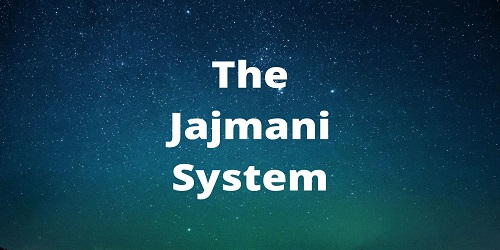Table of Contents
Joint Family System:
Joint Family is a group living in the sense that kinds of several generations live together, eat together, work together, and own common property. Members are bound by their blood relations as well as mutual obligations. There is a rule of paterfamilias in a joint family system.
Definitions of Joint Family:
Following are some definitions of the joint family.
According to Davis, “The joint family consists of males having a common male ancestor, female offspring not yet married, and women brought into the group by marriage. All of these persons might live in a common household or in several households near to one another. In any case, so long as the joint family holds together, its members are expected to contribute to the support of the whole and to receive from it a share of the total product.”
Dr. Irawati Karve says, “Joint Family is a group of people who generally live under one roof, who eat food cooked at one hearth, who hold property in common, who participate in common family worship, and who are related to each other as some particular type of kindred.”
As per Jolly, the joint family consists not only of parents and children, brothers and stepmothers living on the common property, but it may sometimes include ascendants, descendants, and collaterals upon many generations.”
C. B. Mamoria says, “Joint Family is a collection of more than one primary family, the basis being close blood ties, common residence, and patrilineal descent.”
Chandrashekar says, “In a word, joint family is simply the common ownership of the means of production and the common enjoyment of the fruit of labor.”
Types of Families in India:
I. P. Desai has suggested that there are five types of family life in India.
(1) Nuclear Family- The smallest family which consists of a wife, husband, and their unmarried children.
(2) Functional Joint Family- In a functional joint family, two families, having blood relationships, live separately but function under one common authority.
(3) Functional and Substantial Joint Family- When a functional joint family is also joint in terms of property it is called a functional and substantial joint family.
(4) Marginal Joint Family- In a marginal joint family, two generations of family members live together functionally and substantially.
(5) Traditional Joint Family- It consists of three or more generations of people living together in one household, owning property commonly, and participating in family rituals.
Features of the Joint Family:
(1) Depth of Generations- The joint family consists of people of at least three or more generations. It is a confluence of grandparents, parents, and children. Sometimes even blood relations such as uncles, aunties, cousins, etc., and adopted children also live under the same roof. These members are normally blood relatives referred to as “sapindas”. According to Mamoria, “The fundamental principle of the Hindu joint family is the tie of sapindaship without which it is impossible to form a joint family.” The size of the joint family is relatively bigger, sometimes consisting of 8-10 members or even more than that.
(2) Common Roof- Members of the joint family normally reside together in the same household. This common residence is actually the center of all life activities i.e. religious, economic, recreational, social, etc. Henry Maine called this house a “great home”. Due to the scarcity of accommodation or due to educational and employment problems, members of the joint family, that is, members of individual nuclear families within the joint family may reside separately. Still, they try to retain regular contact and the feeling of belonging to the same family. They have emotional and economic links with the original joint families.
(3) Common Eating Place- There is a joint kitchen for all the members of a joint family. The time two separate kitchens are used for preparing meals for some of the members, from that very moment, the family ceases to be a joint family. The food for all old and young, man and woman is cooked in one kitchen. It was commented by Brahaspati, that the people who have a joint kitchen, their ancestors, gods, and Brahmins are worshipped in the same place. It implies that the existence of a joint family kitchen facilitates the members to perform other activities in a single place. The moment, the kitchen is separated, the joint family loses its ground.
(4) Joint Property- Besides a common eating place, and a common shelter, another striking characteristic of a joint family is joint property. The members of the family jointly undertake production and consumption and are joint owners of the wealth of the family. Because of its joint ownership and presence of cooperation among the members it has been called a cooperative institution. The head of the family discharges the function of the trustee and he manages all the affairs of the family in such a way as to provide material and spiritual benefit to all the members equally. The total earnings of the family go to the family head who utilizes it in the interests of all the members of the family.
(5) Headship- The whole gambit of the life of members revolves around the head of the family who is generally the eldest male among the members. He rules over the family and is subsequently obeyed by all the members. Henry Maine has called the head the “absolute authority”. The head rules the family laying more emphasis on love and persuasion and less on rudeness, and suppression. It is the duty of the head to keep in view all the requirements of every member and endeavor to satisfy them to the maximum point of possibility.
Merits or Functions or Advantages of Joint Family System:
(1) It secures the advantage of the sexual division of labor, while men are employed in the public domain and contribute to the family’s earnings, the women usually take charge of the domestic and reproductive sphere. Each member of the family has some allotted work, according to his abilities which he is required to finish.
(2) Living in a joint family system is very economical. Since things are consumed in large quantities they are secured at economical prices. Within small means, a large family can be maintained if it lives jointly.
(3) Every member of the family is ensured of at least some food, clothing, and shelter which are very essential for a minimum existence.
(4) In a joint family, children are properly socialized by training with discipline, patience, cooperation, obedience, generosity, selfless service, etc. which are virtues of social life and the real possession of every individual.
(5) In the joint family the orphans find a comfortable asylum instead of being thrown out. Similarly, widows are assured of their proper living for whom remarriage in India is unthinkable. The joint family acts as a social insurance company for the old, the sick, and the incapacitated.
(6) In a joint family system, leisure is possible as more manpower is available, and due to the division of labor.
(7) According to Sir Henry Maine, the joint family is like a corporation where the trustee is the father. Everyone in the joint family works according to his capabilities but obtains according to his needs and thus the joint family realizes the socialistic ideal.
(8) It fosters great virtues like sacrifice, affection, cooperation, a spirit of selflessness, and broadmindedness among its members and makes the family a cradle of social virtues. Under the care of elders, the undesirable and anti-social tendencies of the young are checked and they are prevented from going astray. They learn to exercise self-control. All members learn to obey family rules and respect their elders.
(9) It avoids fragmentation of holdings and evils inherent therein. Besides keeping the land intact, it also asserts economic production.
(10) The joint family is greatly concerned about children’s education, employment, and marriage, and it plays a critical role in the social placement of the younger generations.
Demerits or Disadvantages or Dysfunctions of Joint Family System:
(1) In a joint family, privacy is denied to the newlywed couple.
(2) It is not favorable to the large accumulation of capital.
(3) It is the home for idlers and drones as the non-earning members do not want to earn their livelihood. When a person can eat comfortably without exerting himself, he is unlikely to indulge in any strenuous activity. Mostly, in the joint family, it happens that some people have to exhaust themselves while others lead a life of utter lethargy.
(4) It is the hotbed of quarrels and bickering, especially among female members. Generally, there is hatred and jealousy between the wives of the brothers. There is continuous strife and fighting over the doings of children. There is also the clash of ideas and temperaments on account of which there are constant quarrels between the elder and young members of the family.
(5) The joint family stands in the way of the development of the individual’s autonomous personality. Independent thinking of other members is restrained and the creative potential of members is not fully tapped or expanded as the opinion of the Karta prevails over all others’ opinions.
(6) The joint family system encourages litigation, for at the time of partition of common property generally disputes crop up which are not settled without a recourse being taken to law. In the case of agricultural families partition leads to the fragmentation of holdings which is harmful from the viewpoint of agricultural progress.
(7) In a joint family, the responsibility for bringing up and educating the children is shared. They do not practice family planning and the result is uncontrolled procreation.
(8) In a joint family, common property is neglected as they do not take any initiative or devote extra personal care and attention. This results in a fall in income and in lowering of standards.
(9) Everyone in a joint family knows that whatsoever he spends will be managed by the family. Therefore, he will not try to save but will spend to the maximum and thus the joint family encourages spendthrifts.
(10) In the joint family system, the condition of women has been found miserable and pitiable. They are required to work throughout the day. They don’t have any opportunity to express their opinions. They are being treated as slaves and their life is miserable.
Disintegration or Disorganization of Joint Family System or Causes for the Changing Family System in India:
Family disintegration or disorganization means the breakdown of consensus and loyalty, often the disruption of previous existing relationships or the loss of family consciousness and the development of detachment. Family disintegration or disorganization may be thought to include most of the non-harmonious functioning within any of several family types. Family disorganization is manifested in the forms of separation, desertion, divorces, suicides, etc. Once the family has disintegrated, the possibility of reconciling conflicting attitudes is extremely difficult, if not impossible.
The following causes may be attributed to the disintegration of joint family in India.
(1) Industrialization- The joint family is most suited to agricultural families. India today is on the way to industrialization. With the establishment of new factories workers from the villages move to the cities and it breaks up the joint family.
(2) Extension of Communications and Transport- Difficulties of communication and travel in ancient times compelled all the members of the family to live together and carry on the family occupation in agriculture and trade jointly. Today when the means of communication and transportation have been extended, it is no longer necessary for men to stay with the family and carry on the family occupation. Now they go to the city and take up any other occupation or even living in the village adopt some other trade and when they adopt a trade different from the family’s trade, they established a new home.
(3) Decline of Agricultural and Village Trade- The joint family system in India flourished when agriculture and trade in the villages were in a sound position. Today with the establishment of factories the commodities produced by the village craftsmen cannot compete in quality or price with those produced in factories with the result is that the village industries suffer a loss ad after some time close down. With the closing down of the village industry, the workers in villages also are compelled to go to the city to find a job there.
(4) Impact of West- Indians have been influenced by western ideologies and thought processes. The laws in our country relating to marriage and divorce were enacted by imperial rules of British India on western lines. Because of the influence of western ideas, there is a growing trend of individualism among the youth of our country.
(5) Women’s Education- The education of women is also responsible for the disintegration of the joint family system. The educated women when married desire to live in a nuclear family to have equality with men.
(6) Overpopulation- Overpopulation resulted in a corresponding increase on the land upon agricultural land. This resulted in increasing unemployment and poverty in Indian villages and the people were forced to part with their families and go away to far-off lands in search of some employment and live separately from their joint families.
(7) Modern Ideas- Due to Urbanization, Sanskritization, and Modernization, an individualistic approach is developed among the people. They prefer to live independently with their small families and take up the welfare of their children. Because of the education and employment of women, she is not able to take up responsibilities in a joint family.









Comments (No)